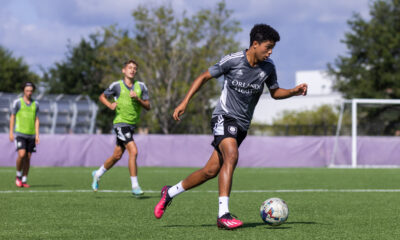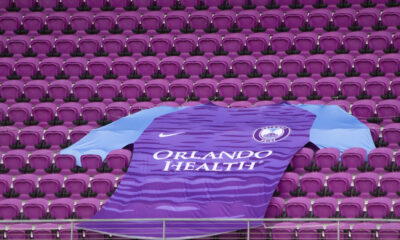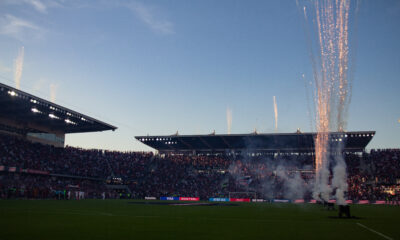Orlando City B
USL Academy’s Impact On Orlando City
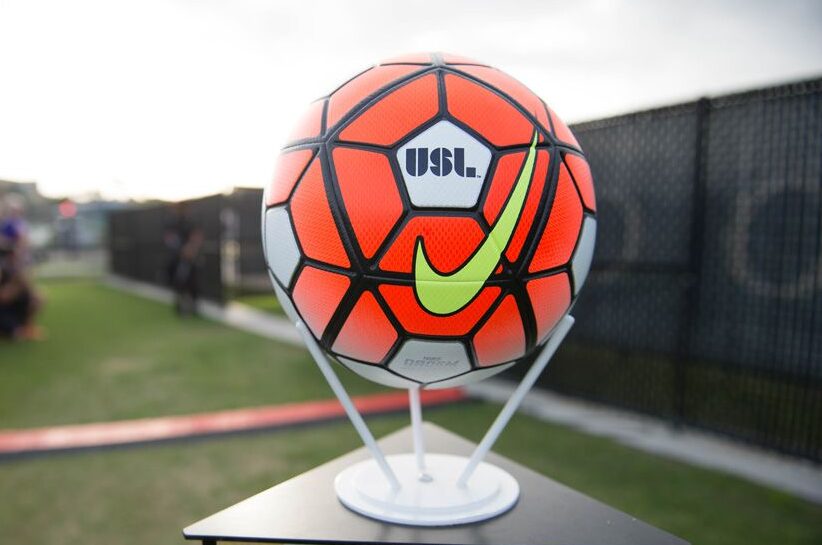
Last week brought the news that the United Soccer League was continuing its restructure, unveiling plans to create a fourth competition with the introduction of the USL Academy Cup later in the year, the organization’s first formal foray into academy soccer. Having moved the entire academy out to Montverde and with the imminent relaunch of Orlando City B, where does both the restructure and the new Academy Cup leave Orlando City?
It’s no secret that the soccer landscape in America has been far from simple to follow. A convoluted web of separate, yet sometimes equal, leagues have come in and out of existence with varying success. Within the last couple of years, the USL ran parallel with the North American Soccer League, both holding second division status in 2017 as sanctioned by the United States Soccer Federation.
This was after the USL was a third tier league even as recently as when OCB was a member in 2016. Since then, a dispute with the USSF forced the NASL into hiatus, where it still remains, while MLS ended its dedicated MLS Reserve league back in 2014, instead requiring teams to enter their reserve teams into the USL or to affiliate with an existing USL team, like Orlando did with Louisville City in 2015.
To add to the matter, a further new third division, the National Independent Soccer Association, has put forward intentions to begin play in August this year. Teams have not been immune to adding to the confusion either, with countless going on hiatus, changing league affiliation, relocating, or folding altogether. In short, there hasn’t been much by way of stability and, as a result, it has proven difficult to properly provide a clear, concise, and reliable pathway from the youth to the professional level.
As of 2019, the USL has created three leagues: USL Championship (USLC), USL League One (USL1), and USL League Two (USL2).
- USLC is simply a rebranded USL, a thriving league that is now the sole second division in U.S. soccer and currently contains 36 teams.
- USL1 is a brand new, fully professional third division that technically contains 12 teams, although only 10 are set to contest the inaugural season beginning later this month, with the newly reformed OCB being one of them. It is the lowest level of professional soccer in the country.
- USL2, unofficially a fourth division, as USSF does not recognize formal levels below the third tier, is now what was formerly known as the Premier Development League. The highest level amateur league was a regular landing spot for elite collegiate talent prior to their MLS draft eligibility. It sits roughly equal to the National Premier Soccer League (NPSL), although the NPSL has no age restrictions, unlike the USL2.
When the USL originally launched the reformat, it marketed USL2 as #Path2Pro, but with the new USL Academy announcement, it appears the league already has plans to extend that vision even further. It should be applauded that the USL continues to take such a significant hands-on role in the nation’s youth development. As its partnership with MLS enters its seventh season, 21 of MLS’ 24 teams have USL ties. Twelve teams operate their own reserve sides (nine in USLC and three in USL1), while nine have affiliate agreements, including two with so-called “hybrid” deals (eight in USLC and one in USL1).
Fielding reserve teams in professional leagues is nothing new. In Spain, for example, reserve sides compete in the same league system, although they are not eligible for promotion to the same division as their parent club, nor can they compete in the Copa del Rey. But other countries, such as England, continue to run dedicated and separate reserve leagues, with the English system running a two-tier system across two age groups.
The USL therefore currently sits in an unusual middle ground as an American hybrid of both systems (minus the promotion/relegation, obviously). The biggest teams, like the hugely successful New York Red Bulls and Portland Timbers systems, not only have a reserve side capable of challenging in the USLC like a La Liga reserve team, but they also run U-23 teams in the amateur USL2 league for players too old to be in academies but not quite at the level of the USLC.
Meanwhile, teams like Orlando City (along with Toronto and FC Dallas) have essentially condensed both of those levels into one, and will field their U-23/reserve hybrid team in the USL1. Orlando folded its U-23 side in 2015 in lieu of OCB’s creation, with the team initially entering what is now the USLC before the hiatus.
The new OCB squad has an average age of just over 20, with the oldest, Evan John, having just turned 24 earlier this year. Coupled with new Executive Vice President of Soccer Operations Luiz Muzzi’s impeccable record of Homegrown Players with Dallas, there’s hope the latest move to USL1 will lay the groundwork for a similar set of results in Central Florida in the future.
FC Dallas’ 2–1 win over Colorado at the weekend saw the Texas team start five Homegrown Players. Orlando City B’s success will not be measured by the final table standings, but by how many players it manages to develop for the senior MLS side, a process that has already started with the likes of OCB midfielder and academy product Jordan Bender already seeing senior minutes in the Orlando City Invitational during the preseason.
Where the Academy Cup Fits In
The move to create the USL Academy Cup seems like the next logical step in formalizing the USL’s vision for soccer infrastructure, giving the opportunity for all its member clubs to host their own academies and bring a level of continuity to the development ladder. It’s not that academy programs don’t already exist. Many sides already have U.S. Soccer Development Academy (DA) or Elite Club National League (ECNL) teams. Indeed, there is a massive surplus with DAs currently boasting 197 clubs scattered across the country, while ECNL lists 94.
The USL’s issue is the lack of alignment. Many of those teams do not have a direct link to professional sides and there are plenty of USL teams across all three levels that currently have no youth setup whatsoever. Only 32 of the USL’s 118 clubs currently have teams competing in the U.S. Soccer Development Academy and a only 10 have teams that compete in other competitions. Meanwhile, a side like Louisville City, which is coming off the defense of its USL title still has no youth program at all.
The USL’s intention, therefore, is not to eliminate those academies but instead to realign them by getting pro teams to engage with community clubs in their shared mission of developing professional players locally and providing a realistic vision of a path to pro soccer. Whether it be by absorbing them into their professional brand, creating formal affiliations, or pooling regional talent in Centers of Excellence, this is what the USL is aiming for.
In theory, having a collective approach with the support of a professional team has very little downside, as pro teams help offset costs. This approach also grows the potential of selling leagues, increases local fan engagement, and helps to accelerate those teams’ timelines that haven’t been able to write a blank check to fully fund a youth program, top to bottom.
Orlando City already has academy sides though, so how does this help OCSC? Well, it does little to affect the OCSC pipeline on a macro level in comparison to other clubs that have no existing academy. However, it could potentially extend the team’s reach and do a better job at identifying local talent earlier and providing these players with better facilities and coaching. What’s more appealing is the competition itself, even in its soft launch.
Initially, the USL Academy Cup looks similar to what the U.S. Open Cup is to professional sides and mirrors what MLS does with the Generation Adidas Cup. Spread across two age groups, it brings academies from the clubs across all three levels of the USL into one tournament.
The U-17s will compete in two regional qualifiers split between the Eastern and Western Conference. Regional results will determine seeding and placement ahead of the national event in May.
The U-13 age group will just compete at the national events. USL Senior Director of Youth Development Liam O’Connell stressed that the USL doesn’t want to cull existing competitions and monopolize the youth market. The competition will merely help flesh out the calendar with an elite competition while keeping costs as low as possible, hence the U-13s not having to go through regional qualifiers. Targeting two key pre-professional age groups, and under the guise of the USL and its professional partners, the competition has the potential to reinforce ideals and aspirations for players hoping to make it in professional soccer without moving abroad.
It might all seem like a pipe dream right now and, frankly, the scale is vast, with the individual nuances of each region, club, or even player far too complex to examine individually. Nor is there any way of predicting the impact the new competition will have both in its debut year and down the road. But in the simplest of terms, it’s a step or two in the right direction for Orlando City and soccer in this country.
Orlando City B
Orlando City B vs. Chattanooga FC: Final Score 2-1 as OCB’s Noah Levis Nets Late Winner
Noah Levis’ late goal sees OCB claim all three points against first-place Chattanooga FC.
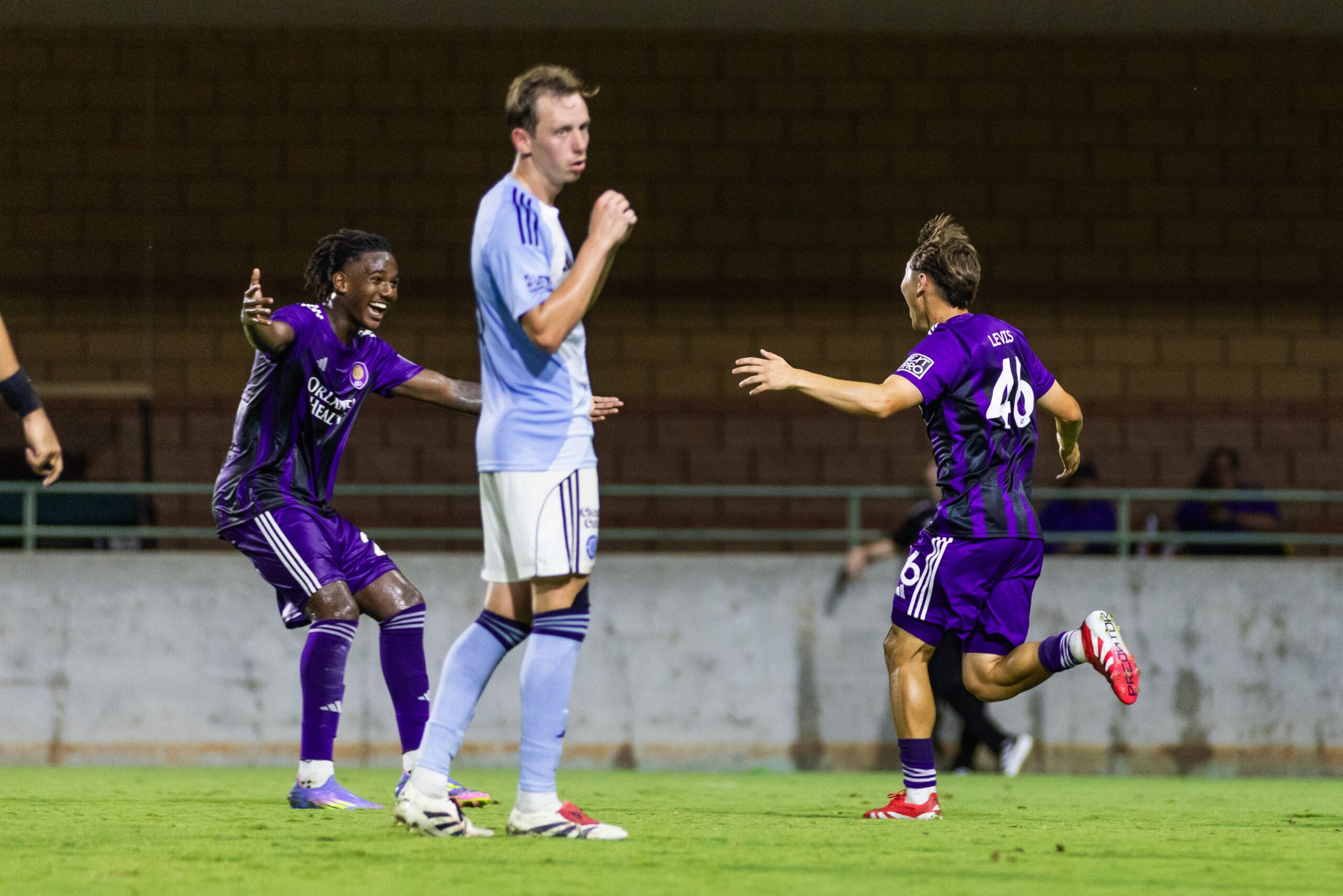
Orlando City B (5-5-1, 17 points) appeared to be headed for a shootout against Chattanooga FC (8-2-2, 27 points) as the teams were tied 1-1 late in the match. But Noah Levis scored in second-half stoppage time to give OCB the win at Osceola County Stadium in Kissimmee.
Shak Mohammed gave the Young Lions the early lead before Steeve Louis Jean equalized just before halftime. Levis’ conversion lifted OCB to a much-needed win against the team at the top of the Eastern Conference.
OCB Head Coach Manuel Goldberg was forced into multiple changes for this game because Jackson Platts, Colin Guske, and Justin Ellis are away with the U-18 United States Men’s National Team. Goldberg replaced the trio of starters with Hardyen Sargis, Gustavo Caraballo, and Favian Loyola. Additionally, Javier Otero joined the second team for this game, replacing Carlos Mercado in goal.
The back line front of Otero was Tahir Reid-Brown, Sargis, Thomas Williams, and Zakaria Taifi. Riyon Tori and Jhon Solis were in the defensive midfield behind Bernardo Rhein, Loyola, and Caraballo with Mohammed up top.
Chattanooga got the first opportunity of the game in the sixth minute when Taifi blocked Milo Garvanian’s cross out for a corner kick. The ensuing set piece went off a visiting player and out for a goal kick, ending the threat.
On the other end, OCB took the first shot of the game in the eight minute. Loyola received a pass near the top of the box before playing it over to Reid-Brown, approaching on his left. Since no defenders stepped up to the left back, he fired from distance, sending his shot over the target.
The Young Lions nearly had a chance in the 11th minute when Taifi found Mohammed near the penalty spot. The forward tried to turn on the ball, but his first touch popped up too high. As a result, Farid Sar-Sar cleared the ball before Mohammed could shoot.
A minute later, OCB took advantage of a Chattanooga mistake to take the lead. Ethan Dudley played a seemingly innocuous pass into the center of the field for Nathan Koehler. But it was a poor pass and Loyola stepped up to intercept. The Young Lions were on a three-on-one break, so it was an easy pass to a wide-open Mohammed and the forward put it in to give the hosts an early 1-0 lead.
Tori and Darwin Ortiz came together in the 20th minute, resulting in both players going down. They required concussion tests and Ortiz was eventually booked for the challenge. While Tori was able to continue, Chattanooga was forced into a concussion substitution, replacing Ortiz with Daniel Mangarov.
In the 26th minute, Otero came off his line to punch a cross away. The clearance went to Louis Jean, who shot from just outside the box. However, the attempt was blocked before it reached the goal.
OCB quickly went the other way and Taifi found Mohammed in the box. The forward was looking to shoot, but he couldn’t find enough space. Instead, he played the ball across for Caraballo. The teenager took a shot at goal, but his attempt was also blocked.
Chattanooga tried to make something happen in the 34th minute from a free kick. Mangarov took the set piece, sending it towards the back post for Koehler. The center back tried to volley the ball and redirect it on goal, but he knocked it out of play instead.
Garvanian knocked Taifi down in the 39th minute, giving OCB a free kick in the Chattanooga third. Solis’ shot was blocked out for a corner kick, and Taifi’s ensuing set piece was back to Loyola. The first-team attacker dribbled forward before shooting from outside of the box, but it was right to Chattanooga goalkeeper Eldin Jakupovic.
As Jakupovic attempted to punt the ball up the field, Mohammed stepped in front. The clearance was off Mohammed’s back and the OCB attacker was booked.
A flurry of activity by Chattanooga resulted in an equalizer in the 43rd minute. It started when Garvanian’s shot was blocked by Caraballo. The block went straight to Mangarov, approaching the end line. The substitute’s second touch was a shot from a tight angle that Otero blocked.
Chattanooga kept possession, resulting in a cross into the box. Otero came off his line and appeared to have an opportunity to catch it, but he punched it away with one hand. In a play similar to earlier in the game, it went to Louis Jean. Again, the Haitian fired from outside the box. However, this time he was directly in front of the goal, The hard shot went past Otero and in, evening the game at 1-1.
The visitors tried to take the lead in the 45th minute when Mangarov did well to shield Taifi from the ball. He played it back for Keegan Ancelin. The midfielder had space for a shot, but he couldn’t get around the ball, sending his attempt well wide.
The final chance of the first half came in the third minute of stoppage time. Taifi lost possession near the top of the Chattanooga box but got it right back. The right back turned to shoot, but he couldn’t get over the ball and sent his attempt way over the target.
After 45 minutes of play, Chattanooga had more shots (7-6) and crosses (6-2). OCB had better passing accuracy (85.2%-84.8%). Both teams ended the first half with two corner kicks, two shots on target, and a goal.
OCB tried to get the second half off to a quick start, nearly converting in the 47th minute. Mohammed did well to shield and turn his defender, getting a shot off towards the back post. The ball skipped past Jakupovic but wide of the far post.
In the 49th minute, Reid-Brown received the ball on the left, outside the box. The left back took a couple of steps forward before firing towards goal. His shot was on target but right into the arms of Jakupovic.
Mangarov tried to create something himself in the 50th minute, beating a couple of defenders to get into the box. He got a shot off, but Williams stuck his foot in and got a piece of it. As a result, the ball went straight to Otero.
Loyola nearly gave the Young Lions their second lead of the night with a long run in the 57th minute. He dribbled into the middle and shot from the top of the Chattanooga box but hit the left post. The rebound ended up with Rhein, but he was offside, ending the attack.
Caraballo took a chance at goal in the 60th minute when he received the ball on the right. The 16-year-old attacker had Taifi making an overlapping run, but he took the chance himself. The midfielder opened up and sent a shot towards the far top corner of the goal, sending his chance wide.
Chattanooga had a couple of opportunities in the 63rd minute, first when Callum Watson found Dudley at the top of the OCB box. Sargis got in front to block the attempt and the visitors maintained possession. Garvanian took the second attempt from the left, aiming for the back post. But he sent his attempt wide and OCB escaped the danger.
In the 67th minute, a long ball by Jakupovic was headed on by Tate Robertson for Peter Plougmand. Otero blocked the attempt that went to Mangarov at the top of the box. The attacker shot right at Otero, who made the stop.
Goldberg made his first change of the night in the 71st minute as Levis came on for Rhein.
Robertson played a dangerous ball to the back post in the 85th minute. He had multiple teammates in the box, but Sargis did well to head it away.
The Young Lions went the other way with Loyola carrying the ball to the top of the Chattanooga box before being taken down by Mangarov, who was booked for the challenge.
Solis was the only person standing over the ball, taking the free kick. However, he sent his shot straight into the wall. The rebound was sent forward for Tori, but the rookie was offside.
Goldberg made another change in the 88th minute, sending 17-year-old Justin Hylton on for his OCB debut, replacing Caraballo.
In the 90th minute, Mike Bleeker found Plougmand in the box. Chattanooga’s leading goal scorer laid it off for Mangarov at the top of the 18, but he couldn’t get anything on the ball, sending it harmlessly wide.
A minute later, OCB took its second lead of the night. Solis and Mohammed combined to send Loyola behind the Chattanooga back line. The attacker took a shot from the right side of the box, forcing Jukupovic into a one-handed save. It looked like the ball was going out of play, but Hylton saved it. He sent the ball towards the penalty spot, where Levis met it and converted to give the Young Lions a 2-1 lead.
“That talks very good about them because they are prepared,” Goldberg said about substitutes Hylton and Levis being involved in the goal. “They are ready. And sometimes it’s tough to play less, but here in the second team, you need to take every chance. We are happy that they took it.”
Goldberg made his final change in the second minute of stoppage time, replacing Loyola with Noham Abdellaoui.
Chattanooga won a corner kick in the third minute of stoppage time and everyone came up, including Jakupovic. OCB cleared with Reid-Brown carrying the ball down field. Without anyone in goal, the left back shot from his own half. Louis Jean sprinted towards his own goal, stopping the ball before it crossed the line, keeping it a one-goal game.
The visitors pushed forward once more, but they couldn’t create anything else, and the Young Lions came away with the win.
Both teams took 14 shots in this game, but OCB put one more on target (6-5). Chattanooga had the advantage in corner kicks (5-3), crosses (10-2), and passing accuracy (86.1%-84.5%), but it was OCB that scored the late goal to claim all three points.
“We are very happy for the win. But, most of all, that we were able to overcome a 3-0 loss (a week ago against Atlanta) beating the team that was top of the league,” Goldberg said. “So, that’s the stand out for us.”
“Obviously, it was a pretty difficult match versus the number one team in the league right now,” Loyola added. “So, it was a pretty hard match to go up front. I think our team played really well defensively and attacking. And, honestly, the mentality we had throughout the game was just amazing.”
OCB moves up to fifth in the Eastern Conference with the win, tied with NYCFC II, a point behind New England Revolution II, and two points behind Huntsville City FC after 11 games.
The Young Lions will take the field again Friday night when they travel to Alabama to face Huntsville City FC.
Orlando City B
Orlando City B vs. Atlanta United 2: Final Score 3-0 as Young Lions Humbled by Atlanta, Selves
OCB falls to Atlanta United 2 in arguably the team’s worst performance of the season.
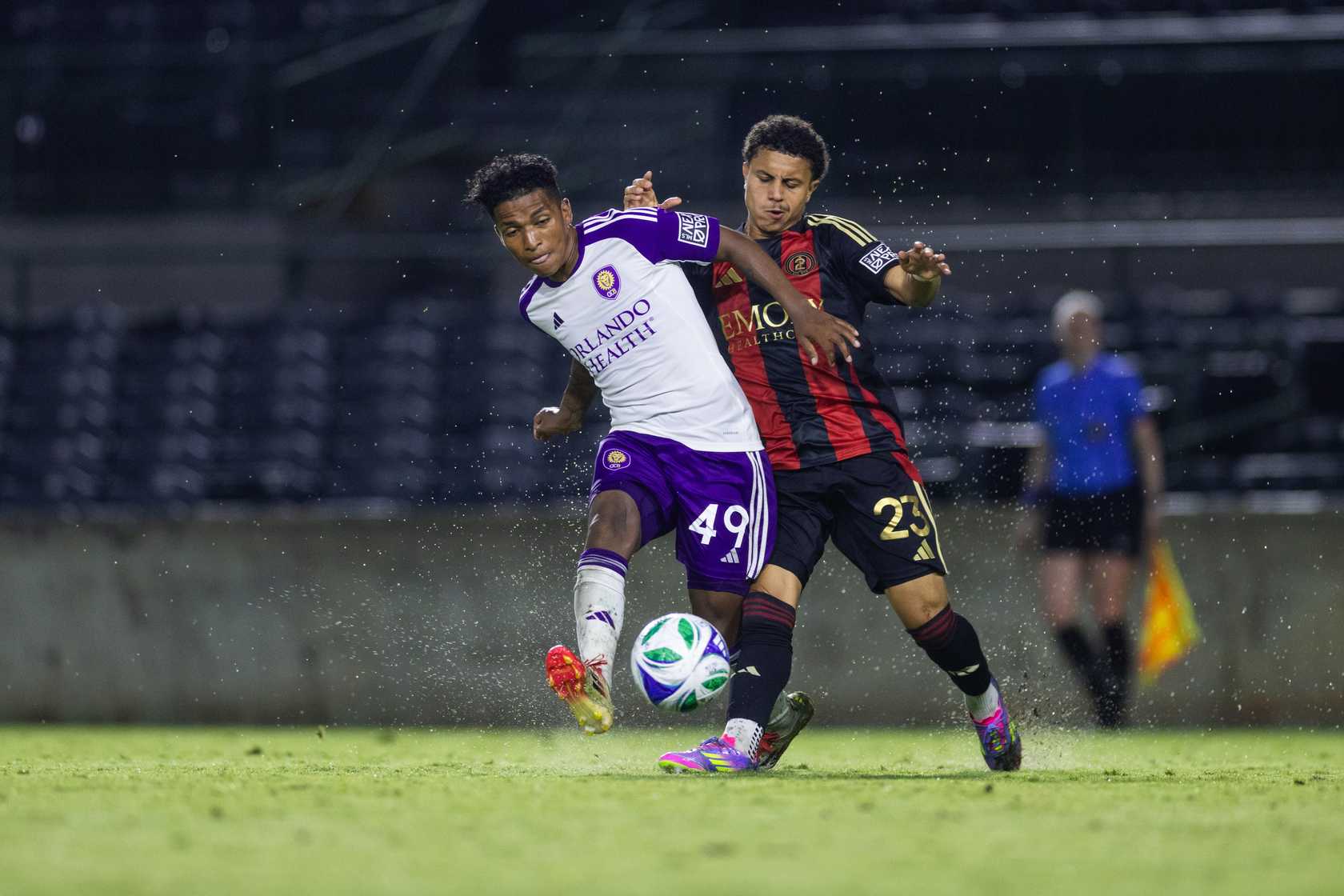
Orlando City B (4-5-1, 14 points) got an extra home game tonight due to a scheduling conflict in Georgia, but instead of taking advantage of not having to play Atlanta United 2 (2-2-6, 14 points) on the road, the Young Lions were humbled 3-0 in their own building. At least they can take some solace that it was a closed-door beatdown that fans couldn’t attend.
Atlanta took the early lead through Gabriel Wesseh’s conversion of a Carlos Mercado howler before Cayman Togashi scored on both sides of halftime.
This game was originally scheduled to take place in Kennesaw, GA, on Friday night. However, due to venue unavailability, it was moved to Osceola County Stadium in Kissimmee. Despite playing in their home stadium, the Young Lions were the away team. Since Atlanta was the home team, OCB’s southeast rivals requested a closed-door game.
As if the two-day delay wasn’t enough, severe weather in the area delayed the game for nearly an hour, finally getting underway at 8:25 p.m. The rain made a difference in the game, as the players had trouble playing on the waterlogged pitch in the early moments.
OCB Head Coach Manuel Goldberg made one change to the team that came away with a 3-0 win over Inter Miami II on May 17. Gustavo Caraballo wasn’t in the team and was replaced in the lineup by Bernardo Rhein.
The back line in front of Mercado in goal was Tahir Reid-Brown, Jackson Platts, Thomas Williams, and Zakaria Taifi. Colin Guske and Riyon Tori were the defensive midfielders behind Rhein, Justin Ellis, and Jhon Solis with Shak Mohammed up top.
The game was pretty much over from the opening whistle. OCB rarely threatened and sent the ball well off target when it did. Meanwhile, Atlanta looked like the only team that wanted to play, constantly creating dangerous chances in the final third.
Atlanta went on the attack early and took advantage of an OCB mistake. Receiving a pass back from Platts, Mercado was out of his box, looking to play the ball up the field, but he sent it directly to Wesseh. Wesseh easily chipped the OCB goalkeeper, putting the ball in the empty net and giving his team the fourth-minute lead.
Javier Armas tried to beat Mercado from distance in the eighth minute, shooting for the far post from outside the box. It looked like Mercado got a hand to the ball, knocking it wide. But the referee gave a goal kick instead.
Guske played a quick free kick to Reid-Brown in the 21st minute, sending the left back to the end line. Mohammed made a run to the near post and Reid-Brown sent the ball in, but it was too close to Jonathan Ransom, who made the save.
In the 22nd minute, Armas found Nykolas Sessock making an overlapping run on his right. The right back had Cayman Togashi and Dominik Chong Qui making runs into the box and sent in a hard cross, but nobody could get on the end of it and the ball went all the way through the box.
Taifi won a corner in the 24th minute when his cross was blocked out of play by Braden Dunham. The right back took the set piece, sending it to the back post. Platts outjumped his defender to get his head to the ball, sending it just over the crossbar.
Atlanta had a series of corner kicks in the 28th minute. The second found the head of Salvatore Mazzaferro, who redirected the ball towards goal. It was on target but went off the shoulder of Reid-Brown. The ensuing corner was cleared, ending the extended attack.
Armas had the ball in a seemingly innocuous spot in the 31st minute. The Atlanta captain fired a shot on target from distance, but Mercado blocked it down and collected it.
OCB had one of its rare first-half chances in the 35th minute when Ellis found Mohammed making a run into the box. The forward took a touch towards the end line, slightly cutting down his angle before firing it into the arms of Ransom. That was the only OCB shot on target in the game.
On the other end, Armas found Wesseh on the right. The midfielder had plenty of space, taking a touch inside before attempting another long shot towards goal. This time it was too close to Mercado, who made the stop.
In the 38th minute, Chong Qui was making a run to the top of the box when Taifi met him. The ball popped in the air towards goal where Sessock was making a run. He nearly got to the ball before Mercado, but he couldn’t quite reach it and the OCB goalkeeper picked it up.
Solis tried to win the ball from Chong Qui in the 40th minute, ultimately tripping the midfielder and giving Atlanta a free kick. Armas stepped up to take the set piece, sending it to the far post. He had Mercado beaten, but the ball bounced off the woodwork, keeping the OCB deficit at 1-0.
Atlanta doubled its lead in the 45th minute from a free kick in its own third of the field. Chong Qui flicked Mazzaferro’s long set piece into the box. Platts and Togashi went after the ball, with Platts getting there first. But Togashi muscled the center back off the ball. Mercado had started to come out, but changed his mind when Togashi had possession. With the goalkeeper caught in no-man’s land, Togashi touched it around the OCB goalkeeper and into the once-again wide-open net to give Atlanta a commanding 2-0 lead.
After 45 minutes, Atlanta had the advantage in shots (9-5) shots on goal (4-1), corner kicks (3-2), and passing accuracy (85%-83.3%). OCB had more crosses (2-1), but the best chances were by the team in stripes.
Goldberg made one change at halftime. Rhein, who went down earlier in the first half, was replaced by Favian Loyola.
Atlanta continued its attack on the OCB goal out of the break, creating a chance in the 50th minute. Chong Qui dribbled towards the top of the box before firing. It looked like the shot might be on target, but Taifi stepped in front to block it.
In the 55th minute, Sessock dribbled into the box before laying the ball off for Armas. The attacker tried to lift the ball over Mercado, but couldn’t get it to come down, and it sailed over the crossbar.
Ransom cleared the ball way up field in the 57th minute. Mercado came out of his box, but Togashi beat him to it. The attacker chipped the ball over the OCB goalkeeper and it appeared to be going in, but Williams got back to knock it out of play, keeping the deficit at two goals.
Solis intercepted a pass at midfield in the 59th minute, heading the other way. The midfielder was pulled down by Armas before he could reach the ball, earning a yellow card. Solis took the free kick himself from a position in which he’s scored before. However, he sent this one directly into the wall.
Mohammed played the ball back for Loyola from the corner in the 61st minute. The halftime substitute lifted it into the box where Taifi was making a run. He went over the defender and got a head to it, sending it wide.
Solis had another chance from a corner kick in the 66th minute when Atlanta failed to clear the ball. The midfielder found a way through multiple defenders and had a good look at goal, but sent the shot over the top.
After receiving a pass from Platts, Loyola lost the ball to Cooper Sanchez in the 68th minute. Dribbling into the OCB third of the field, he found Togashi near the top of the box. Reid-Brown was there to defend, but Togashi spun to lose him and tucked the ball into the far bottom corner to make it 3-0.
In the 70th minute, Solis made a good, long run into the Atlanta half of the field. He played it centrally for Ellis, who quickly sent it on for Loyola. The first-team forward had a good look at the goal, but his shot went wide.
Solis tried to play Reid-Brown a long ball in the 72nd minute, but Sessock got their first, playing it back to his goalkeeper. However, Ransom was under pressure from Reid-Brown and played a terrible ball out of the back, sending it straight to Loyola. The goal was wide open, but Loyola sent the ball over the top.
Goldberg made two more changes in the 74th minute. Hayden Sargis and Diego Pareja came into the game for Guske and Platts.
Former OCB attacker Moises Tablante made a long run to the top of the OCB box in the 76th minute before being taken down by Williams. The center back protested the decision, but Atlanta had a free kick in a great position.
Armas stepped up to take the set piece and went for goal. It was a hard shot that fortunately went well over the crossbar.
A stoppage of play in the 78th minute gave Goldberg the opportunity to make his fourth change of the game. Noham Abdellaoui came on for Williams.
A long ball out of the back by Chong Qui in the 82nd minute found Wesseh across midfield. The forward beat the new center back pairing of Abdellaoui and Sarigs to get in on goal. As Abdellaoui caught up with the attacker, Wesseh shot. However, Mercado did well to come off his line and tip it wide.
It was a frustrating night for the Young Lions, which was on full display in the 88th minute when Solis played Reid-Brown down the left. Sessock did well to shield the OCB left back, winning a goal kick. Reid-Brown kicked the advertising board in frustration after being out-muscled by his smaller opponent, a perfect representation of the night for Orlando.
Mercado nearly made a costly error in the 90th minute when he played a ball out of the back directly to Adyn Torres. However, the Young Lions were able to win it back and draw a foul to avoid any more danger.
Wesseh received a pass at the top left corner of the box in the second minute of stoppage time. He was given plenty of space, so he took the shot himself, sending it wide of the far post.
A minute later, Ryan Carmichael made a run into the OCB box and sent a dangerous ball across the face of goal. Fortunately, nobody in black and red was close enough to get on the end of it and the ball went out of play.
That was the final chance for either team as Atlanta came away with a dominant 3-0 win. At full time, Atlanta had the advantage in shots (23-12), shots on target (7-1), and corner kicks (5-4). OCB had better passing accuracy (84.2%-80.1%) and both teams had five crosses.
It was an abysmal performance by OCB. Every player made costly mistakes, and the team failed to threaten the Atlanta goal. Even when defensive mistakes by the opposition gave the Young Lions a golden opportunity, they found a way to mess it up.
The Young Lions are currently in eighth place, barely above the red line. However, they’re now tied with Atlanta on points and only one point ahead of Chicago Fire II and Inter Miami II.
OCB will have to shake this one off and find a way to rebound when they host Chattanooga FC on June 1.
Orlando City B
Orlando City B vs. Inter Miami II: Final Score 3-0 as Young Lions Dominate Herons At Home
Justin Ellis’ goal and two assists helped end a five-game winless run against the Herons.
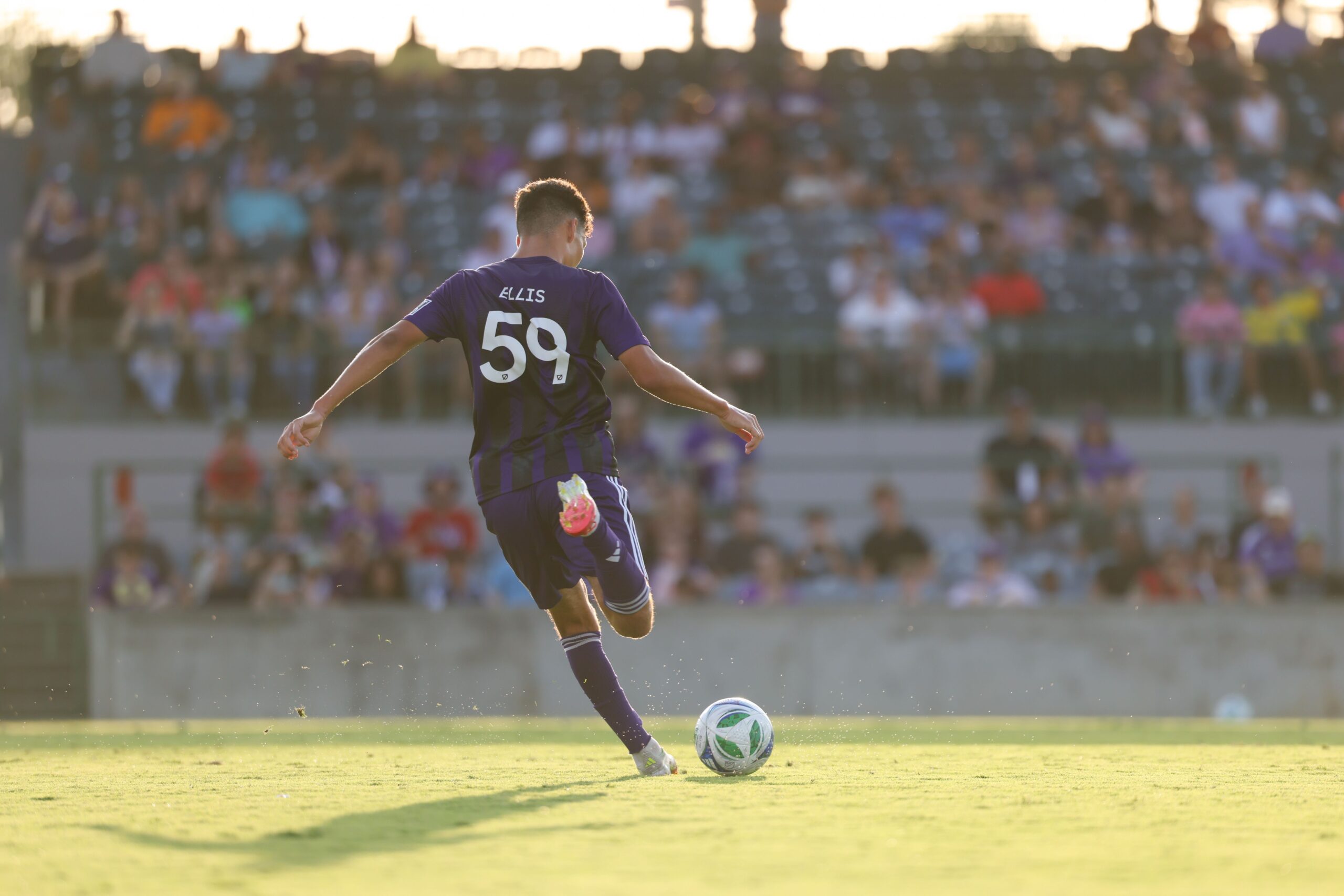
Orlando City B (4-4-1, 14 points) returned home tonight and crushed Inter Miami II (3-6-1, 10 points) 3-0 at Osceola County Stadium in Kissimmee. Gustavo Caraballo gave the Young Lions the lead in the 19th minute before Shak Mohammed doubled the advantage in the 51st minute. But it was Justin Ellis’ night. The 18-year-old assisted the first two goals and converted a penalty in the 59th minute to cap off a remarkable game.
OCB Head Coach Manuel Goldberg made just one change from the team that lost 5-1 to Chicago Fire II on May 2. Jhon Solis returned to the starting lineup after his one-game suspension, replacing Juan Quevedo.
The back line in front of goalkeeper Carlos Mercado was Tahir Reid-Brown, Thomas Williams, Jackson Platts, and Zakaria Taifi. Colin Guske and Riyon Tori were the defensive midfielders behind Solis, Ellis, and Caraballo with Mohammed up top.
Miami got off to the stronger start in the first five minutes and it looked like it might be another long night for OCB. But that was the end of the threats by the opposition. The Young Lions seemed to wake up and dominated the rest of the game. The 3-0 scoreline is a fair result as OCB was by far the better team.
The visitors nearly took the lead in the fifth minute when Santiago Morales’ shot hit the post. The rebound went right back to the midfielder, who found Cesar Abadia-Reda to his left. The defender sent a second shot towards goal but hit it just wide of the near post.
A minute later, the Young Lions felt they should’ve had a penalty when Reid-Brown found Mohammed down the left. The attacker played the ball into the box for Caraballo, who went down after contact from behind. The OCB players and fans appealed for a penalty, but the referee disagreed.
Alejo Ristano pulled Ellis down in the 12th minute, giving the Young Lions a free kick near the top of the Miami box. Caraballo and Solis stood over the ball with Solis taking it. His set piece got through the wall, but Ivan Schmid had eyes on it the entire way, making for an easy save.
The Young Lions took the lead in the 19th minute when Mohammed found Ellis at the top of the Miami box. Caraballo was making a run, and Ellis chipped it in for the midfielder. The 16-year-old did well to control the ball and put it past Schmid to give his team the 1-0 lead.
It looked like OCB might double its advantage in the 22nd minute when the Young Lions broke forward on a four-on-two break. Mohammed played the ball to his right for Caraballo, who immediately tried to find Ellis in the middle of the field. However, the pass was behind the attacker and the Young Lions were unable to create a shot.
In the 39th minute, Abadia-Reda sent a dangerous cross through the OCB box, looking for Ricardo Montenegro. Fortunately, he wasn’t able to connect, because Mercado would’ve had little chance if the midfielder had redirected it on target.
OCB won a corner kick in the first minute of first-half stoppage time. The set piece found Williams near the top of the six-yard box with Giovanni Ferraina holding the center back, causing his header to go wide. Williams threw his arms up, feeling a penalty should’ve been called, but nothing came of it.
Both teams created three shots in the first 45 minutes, but OCB put two on target while Miami only put one on frame. While Miami had the edge in crosses (2-0), corner kicks (3-1), and passing accuracy (91%-87.8%), Caraballo’s 19th-minute strike gave the Young Lions that one-goal halftime lead.
Goldberg made a pair of halftime changes, possibly in preparation for Sunday night’s first-team game in Fort Lauderdale. Favian Loyola and Dylan Judelson came into the game for Guske and Caraballo.
OCB doubled its advantage in the 51st minute and it was created by Ellis again. The attacker received the ball at the top of the Miami box, and — similar to the first goal — chipped it forward. This time it was Mohammed making the run, playing it past Schmid to make it 2-0.
Miami looked to respond in the 56th minute when Idoh Zeltzer-Zubida found Morales in the box with some space. The midfielder’s second touch was a shot on goal, but Mercado was at his near post to collect it.
Things got even better for OCB in the 57th minute when Loyola made a run into the Miami box from the right and shot. Tyler Hall turned his back to the ball and it went off his arm. The referee immediately pointed to the spot, awarding OCB a penalty.
After setting up the first two goals, Ellis stepped up to take the spot kick. There was a delay while the referee made sure the players were outside the box. When his whistle blew, Ellis didn’t hesitate to take the attempt, putting it past a diving Schmid to make it 3-0.
“It was just the confidence that my teammates and the staff give me,” Ellis said about his goal and two assists. “Like the freedom that they give me. They tell me where to be and then I just execute.”
“He has a lot of determination in the last third. We tried to take advantage, he tried to take advantage with his teammates,” Goldberg said about Ellis’ performance. “He assisted twice and scored, so we are really happy for him.”
The Young Lions nearly made it 4-0 in the 63rd minute when Ellis made a good run into the box, and his pass split two defenders and found Taifi. The right back had his back to goal, so he laid it off to Mohammed instead. Mohammed quickly shot, but Schmid blocked it over the crossbar.
The ensuing corner kick was long, finding Platts beyond the back post. The center back sent the ball in front of goal with a teammate there, but it was cleared away.
OCB dominated the second half, but Miami created a chance in the 69th minute when Yuval Cohen got enough room from his defender to get a shot off. However, he sent the attempt well off target.
Immediately after the miss, Goldberg made his third change of the night, replacing Taifi with Hayden Sargis.
Ellis was looking for his third assist and fourth goal contribution in the 72nd minute when he played Mohammed behind the Miami back line. But this time the flag went up, ruling the striker offside.
Alejandro Flores forced Mercado into action in the 73rd minute with an ambitious shot from distance. The attempt was heading inside the near post, but Mercado did well to dive to his left and push the ball wide.
In the 76th minute, Mateo Saja was taken down just outside of the OCB box, giving Miami a free kick in a dangerous position. It was a fortunate play for the Young Lions because Saja was entering the box when he was taken down.
Before the set piece could be taken, Goldberg made another change as Bernardo Rhein came on for Ellis.
Morales sent the set piece towards goal. The ball went off Mohammed, sending it just wide of the target. The Young Lions cleared the ensuing corner kick and Miami was unable to get anything else from the attack.
Goldberg made his final change in the 85th minute as Noah Levis made his OCB debut, replacing Solis.
A free kick in the 89th minute resulted in a dangerous situation. Schmid came flying out for the set piece, running into Platts and flipping over the center back. The referee called Platts for a foul and both players went down. However, neither needed attention and both were able to continue.
Miami quickly went the other way and created a chance. There were multiple pink jerseys in the box as the low cross came in, but Mercado jumped off his line to collect it before anyone could put it on target.
In the final minute of stoppage time, Cohen wound up and shot from well outside the box. The attempt got through a pair of defenders, but Mercado had his near post well covered, smothering the ball. The final whistle blew before he could punt the ball away, securing the 3-0 win for the Young Lions.
Inter Miami II had the better statistical night with the advantage in shots (11-8), crosses (7-4), corner kicks (6-3), and passing accuracy (91%-86.6%). But both teams put five shots on target and OCB created much more dangerous situations.
“The first thing, to win the derby is great. So that’s the most important,” Goldberg said. “Apart from that, I think we did it in a good way, which is even better.”
“It was a great team performance,” Ellis added. “I think the defensive solidity gave us the confidence to score three goals, and it gave us the freedom to play for what we see and just use our talent.”
The win snaps a five-game winless run against Miami, during which the Young Lions went 0-3-2. Prior to tonight, the most recent OCB win came on May 25, 2023, a 1-0 win in Fort Lauderdale.
After a short stop at home, OCB will head back out on the road to face another rival in Atlanta United 2 Friday night in Kennesaw, GA.
-
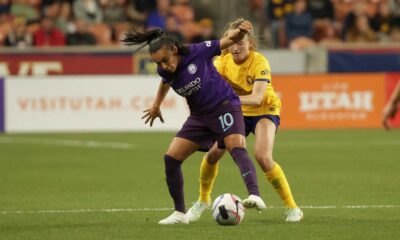
 Orlando Pride2 weeks ago
Orlando Pride2 weeks agoOrlando Pride vs. Utah Royals: Preview, How to Watch, TV Info, Live Stream, Lineups, Match Thread, and More
-
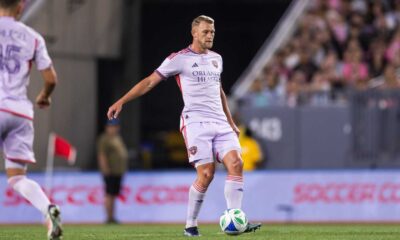
 Orlando City2 weeks ago
Orlando City2 weeks agoOrlando City vs. Portland Timbers: Preview, How to Watch, TV Info, Live Stream, Lineups, Match Thread, and More
-

 Orlando City2 weeks ago
Orlando City2 weeks agoOrlando City vs. Nashville SC: Five Takeaways
-
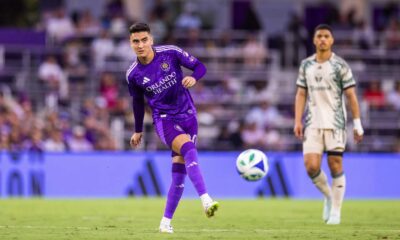
 Orlando City2 weeks ago
Orlando City2 weeks agoOrlando City vs. Portland Timbers: Final Score 1-0 as Lions Tie Club-Record 12-Game Unbeaten Streak
-
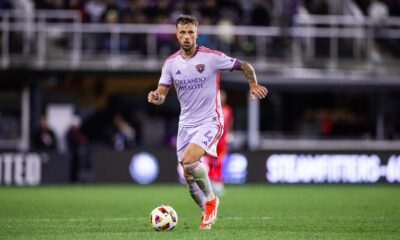
 Lion Links7 days ago
Lion Links7 days agoLion Links: 5/30/25
-
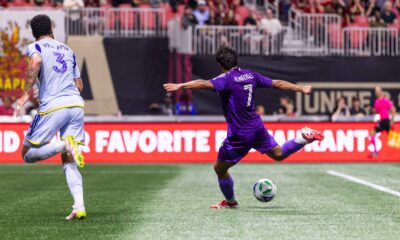
 Orlando City1 week ago
Orlando City1 week agoOrlando City vs. Atlanta United: Final Score 3-2 as Late Araujo Red Card Turns Orlando Lead into a Loss
-
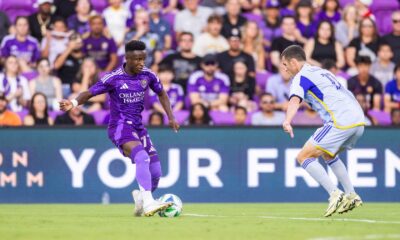
 Orlando City1 week ago
Orlando City1 week agoOrlando City vs. Atlanta United: Preview, How to Watch, TV Info, Live Stream, Lineups, Match Thread, and More
-
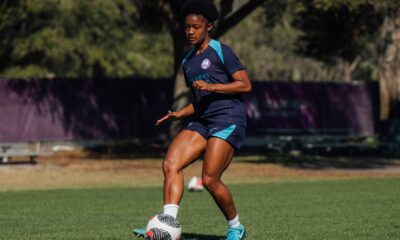
 Orlando Pride1 week ago
Orlando Pride1 week agoOrlando Pride Sign Forward Simone Jackson Through 2028


